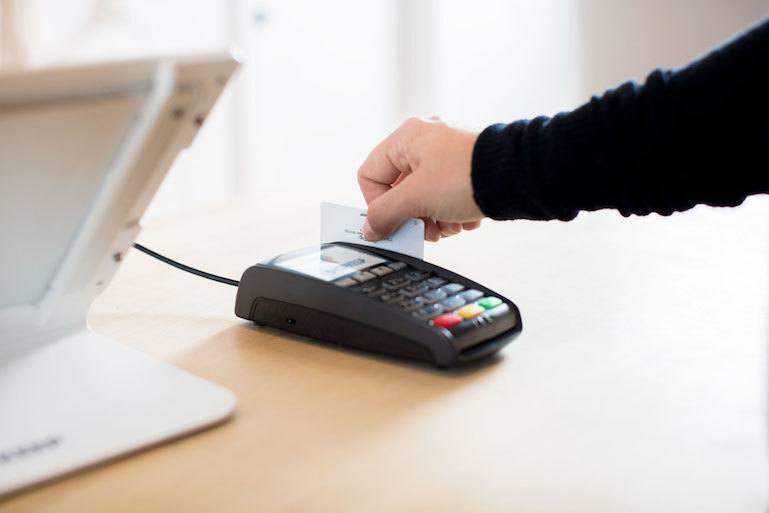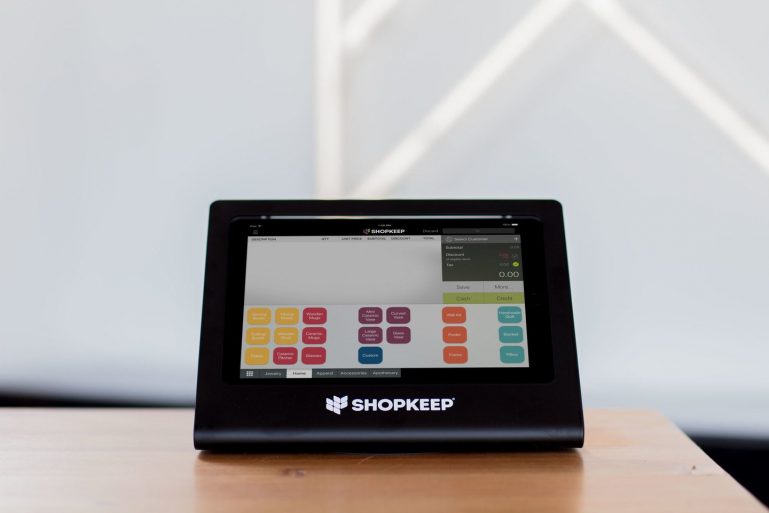
What is Square Up? And Is it Really Right for Your Business?
What is Square Up? If you’re a small business owner looking for an easy way to accept credit card payments, you may have heard of a company called Square Up.
What is Square Up? If you’re a small business owner looking for an easy way to accept credit card payments, you may have heard of a company called Square Up. Square Up — as their domain implies — or just Square as they’re more commonly called. They started as a payment processing service that tried to disrupt traditional credit card processing by giving anyone the ability to quickly and easily accept credit cards.
They’re best known for their square, white credit card reader dongle that plugs into the headphone jack of a mobile device like an iPhone or Android phone. Square has since tried to expand from this simple service to offering a more robust point of sale system that can be used by retail and food service businesses.
Side Note: Square is also well-known for sharing their CEO, Jack Dorsey, with his other company, Twitter.
Square hit the market in 2010 and disrupted the merchant services industry by becoming a payment aggregator. They sidestepped the traditional underwriting process for a merchant account and became a broker for an already brokered service (merchant services) to an underserved market of micro-merchants and hobbyists.
Fast forward almost ten years, and you’ll find that Square is still an aggregator, but they’ve also shifted away from that core business. Let’s take a closer look at what Square has been up to.
What Square Does Well
For small business owners trying to understand the complex world of credit card processing, it’s about as painful as a root canal. There are interchange fees, payment gateway fees, PCI compliance fees, qualifying transactions, non-qualified transactions, and other terms and conditions than the average merchant understands. And that’s only if you were approved for an account.
Not all merchants are automatically approved for a merchant account. With traditional Merchant Service Providers (MSPs), there is an underwriting process for your account to be approved. Much like a small business loan or merchant cash advance, the account provider analyzes factors such as personal credit, years in business, and the type of business you operate to determine their risk for bringing you on as a client. If the MSP determines your business is high risk, they’ll decline your account. Leaving you high and dry with no way to take payments
Enter Square. Square has built a reputation for offering simple, flat-rate credit card processing fees for small businesses. No more confusing fees and complicated merchant statements, just one flat rate per transaction for magstripe, NFC (Apple Pay, Google Pay) and EMV chip cards (2.75% + $0.10), and another for keyed-in transactions (3.5% + $0.15). They own the relationship with the payment processor, inflate the rate, and pass it along to you.
To their credit, this business model did make life much easier for a lot of people with side-hustles or service businesses that needed an easy way to accept credit card payments every now and again. Kudos to them in that regard.
Squarely Room for Improvement
While this new way to accept payments was groundbreaking for some merchants, it’s not a viable long-term solution for many. It’s not a cure-all for small businesses or entrepreneurs like they claim to be. Trust us. We know first-hand from converting Square merchants to the ShopKeep platform.
“We switched over from Square, and we were very nervous to learn a whole new system. ShopKeep is so amazing! It has made our life much simpler with our vape shop! We are two satisfied customers” – Samantha, MidWest Vape
Over the years, Square has shifted from its core business as just a payment acceptance platform to include an array of other solutions. In no particular order, these solutions include:
- Square Point of Sale
- Square for Retail
- Square Register
- Square Stand
- Square for Restaurants
- Square Cash (peer-to-peer payment service)
- Payroll services
- Merchant cash advances from Square Capital.
- Last but not least, Square Wallet which failed to gain mainstream adoption and was eventually pulled three years after its launch.
On the surface, all this looks pretty great. They’re averaging about one new product per year and expanding the small business ecosystem. With their recent acquisition of Weebly, it seems they’re still keeping that pace. However, if you dig a little deeper, you’ll start to see the flaws. Let’s set the stage with fictional entrepreneur John Dough so you can see what we mean.
The Story
John got bit by the entrepreneurial bug and decided to become a vendor at a local flea market on the weekends. His specialty is hand-rolled artisan donuts and complementing beverages like specialty coffees, teas, and maybe some fresh apple cider. During the first weekend, he quickly realizes a lot of patrons want to pay by credit card, but he doesn’t have a way to accept that form of payment.
He needs a quick fix so he checks out Square because another vendor told him it only takes about five minutes to set up a Square account and he can quickly sign up in the Square app or online. A few days later he receives the free Square card reader in the mail, and he’s ready to rock-and-roll.
Fast forward 12 months and the donut and coffee stand did so well that he decides to open a brick-and-mortar location. Now he needs more than just a way to accept payments from his smartphone. He needs a countertop POS system. Since he already uses Square for payments, he decides to spend $1000 to purchase the hardware for Square Register.
The Roadblocks
Here’s where the problems begin. Now that he has a physical coffee shop that’s open seven days a week, his transaction volume has grown exponentially. Sales have increased, and so has the average ticket amount. Not only does he have more customers, but those customers are spending more per visit. The business is growing, and he’s making more money – except that he’s not because Square is taking more of his money and freezing his account from time to time.
Although Mr. Dough has had a few hiccups with his Square system, he decides to stick with them when he adds a second location and experiments with a retail component by selling branded coffee mugs, shirts, and other related novelty items. He’s a loyalist, and he doesn’t want the hassle of choosing a different POS system.
He quickly finds out Square Register isn’t designed for multi-location functionality, but Square for Retail is. And since the same company makes them, he figures he can sync his inventory from one solution to the other for a smooth transition. Except that he can’t because not all of Square’s products are integrated with one another. He basically has to start from scratch if he decides to move to Square for Retail.
Taking it a step further, Mr. Dough decides to add delivery service during the weekend morning rush. Except that he can’t. Square for Retail isn’t designed with a delivery element like Square for Restaurants is.
In a recent interview, Mount Burns, owner of St. John’s Coffee Roasters talks about his first-hand experience using Square and the limitations he faced as he expanded his business. For more detail, jump ahead to 3:42 in the audio file below.
The Downfall
The downfall with Square is that they are building many products to serve a lot of different business types. While they are plumping up their small business ecosystem, they are doing so with quantity, not quality.
The hard limits they enforce on functionality and features only being available for specific products, make it impossible for businesses to stick with them once they reach a certain level of growth. And speaking of growth, ValuePenguin does an excellent job of highlighting how businesses that process more than $500,000 in credit cards or debit cards will cost them about $3,000 more per year processing with Square rather than a traditional merchant service provider. We don’t know about you, but that’s a lot of dough!

Are There Any Alternative Options for Square?
There is no doubt that Square was a pioneer in mobile payments by giving away a free magstripe reader, charging a seemingly risk-free rate with a flat per transaction fee, and enabling anyone to accept credit cards. They were a game-changer and came into the market with a bang, and we’re not here to take away from that. What we are here for is to let you know that Square isn’t the only game in town.
If you’re operating a real business and you want to accept credit cards, the best thing you can do is set up payment processing the conventional way – using a merchant service provider and bank account, not an aggregator. An aggregator sounds a lot like aggravation, and after reading some of Square’s reviews on Trustpilot, it seems like aggravation is all Square users get.
Instead of settling for Square because you need a quick and dirty fix to process card transactions, take the time to figure out not only what you need in your business today, but also your long-term goals.
Are you content with your casual business and don’t have any intentions of expanding like our friend Mr. Dough? If so, a Square-like solution for simple payment acceptance is probably a viable option.
On the other hand, if you’re serious about your business or you have aspirations of turning your side-hustle into a something more serious, you’re better of with a cloud-based POS system that’s integrated with true payment processing.
As experts in the industry here at ShopKeep, we’re going to let you in on a little speculative secret as to why Square is notorious for withholding money, freezing accounts, and shutting them down altogether.
We mentioned at the beginning of this article that Square is an aggregator. They own the relationship between you, the merchant, and the bank that is actually funding them, to fund you. Are you with us so far? Good, let’s keep going.
Do you remember what we said about how long does it take to set up Square and how you get an account? Right, about five minutes and literally anyone can sign up for the service online or by downloading the app.
Lastly, do you recall what we said about traditional merchant accounts – that there’s an underwriting process to get approved? Well, with Square that underwriting process happens on the backend – after you sign up. Rather than making sure you and your business are legitimate before they let you use their platform, Square lets everybody in. Once you start using the service, your account is going to be heavily monitored for what they deem suspicious activity – aka fraud.
The problem with this model is that it seems their definition of fraud is much more stringent than that of a conventional payment processor. And the reason for that is because they take on so much more risk up front – because they don’t do the underwriting up front.
What does all that mean for you, Mr./Mrs. Entrepreneur? It means that because they take on so much risk upfront by ‘approving’ anyone, they need to be more cautious (especially in the beginning) on how quickly they fund your account. So if you display activity that appears suspicious (rapidly scaling up your transaction volume), because your business is healthy and growing, they will pause your account and withhold your funds, even though you’re doing nothing wrong.
The Bottom Line
So, what is Square Up? The bottom line is that they’re a payment aggregator. They took some Twitter money and disrupted the credit card processing industry by making it easy for hobbyists and part-time businesses to accept credit cards with nothing more than a smartphone and a dongle. They’ve since tried to expand upmarket into the POS systems used by more serious businesses with some success, but also a lot of sacrifices. Ultimately, if you’re running a full-time business that needs to process a consistent and sizeable amount of payments, as well as the full power of a point of sale system, there are much better options out there.
Want to try ShopKeep for yourself?
Just answer a few easy questions.
Need help finding the right point of sale?
Just complete the form. We’ll call you right back to explain how ShopKeep can work for you.
Hit the ground running.Sprinting, in fact!
Read our free, comprehensive guide, Small Business 101, to learn all you need to know about starting a thriving business.

